Posted by
Susan Sharma
on
March 07, 2010

Sinking Island-Majuli
Majuli in upper Assam is the largest river island on the Brahmaputra River . It is a pollution free fresh water island. Total area of the island was 1250 sq.km., now it is about 650 sq.km, having lost significantly to erosion. Only 26 percent of total land
area of Majuli is suitable for cultivation.
In the 16th century a sage called Shankardev founded a new sect of Vaishnavism here, which has flourished healthily in the last five hundred years. Today, the ‘sattras’ play a major role in the religious and social lives of every inhabitant of Majuli. Every
family sends one son to be a monk, usually from the age of six; the belief is that if one son becomes a monk, then the whole family will be blessed by God. With pilgrims flocking here every year in numbers matched only by the migratory birds for which the
island is also a haven, Majuli is known in some circles as the ‘Vatican of Vaishnavism’.
Performed by the monks of the Bhogpur Sattra at the Birla Mandir, New Delhi on 20th February, 2010, the dance clip below, has no song or words but strangely resonates with the uncertain future of this island.
The island today is separated from the mainland of Assam by 2.5 KM. Apart from the ferry connecting Majuli to mainland, an “e-Sethu” or e-governance project of Government of India connects the village to Assam. A wetland, Majuli is a hotspot for flora
and fauna, harbouring many rare and endangered avifauna species including migratory birds that arrive in the winter season. Among the birds seen here are: the Greater Adjutant Stork, Pelican and Whistling Teal. The island is almost pollution - free owing
to the lack of polluting industries and factories and also the chronic rainfall.
A UNDP study reports that the island is under threat due to the extensive soil erosion of its banks. The reason for this magnitude in erosion is the large embankments built in neighbouring towns upriver to prevent erosion there during the monsoon season
when the river distends its banks. The upshot is a backlash of the tempestuous Brahmaputra’s fury on the islet, eroding most of the area. According to reports, in 1853, the total area of Majuli was 1,150 km² and about 33% of this landmass has been eroded in
the latter half of 20th century. Since 1991, over 35 villages have been washed away. Surveys show that in 15–20 years from now, Majuli may cease to exist.
Here is another evocative clip, a dance by Sattriya Dancers of Kalabhumi- one of complete surrender to fate?
|
Posted by
Susan Sharma
on
February 26, 2010

 We, barbets are great at home building. Apart from finding something to eat, pecking a hole on the tree keeps us occupied for the best part of our life. (After all we are related to the famous woodpeckers!)
We, barbets are great at home building. Apart from finding something to eat, pecking a hole on the tree keeps us occupied for the best part of our life. (After all we are related to the famous woodpeckers!)
 When this neat hole on a wild neem tree was complete, we had reason to be proud of our handy work. We managed raising two broods inside during the summer months and our chicks are now grown up and flying about on their own. During winter, we normally fly away
to warmer climes, what are wings for anyway. It seemed appropriate to rent out our premises to other needy folks. But look at what the ants have made of it. They are really dirty housekeepers.
When this neat hole on a wild neem tree was complete, we had reason to be proud of our handy work. We managed raising two broods inside during the summer months and our chicks are now grown up and flying about on their own. During winter, we normally fly away
to warmer climes, what are wings for anyway. It seemed appropriate to rent out our premises to other needy folks. But look at what the ants have made of it. They are really dirty housekeepers.
 When the squirrels came and cleaned up the mess, we were happy. The squirrel kids were snug and warm for the winter. Not one but two families lived inside.
When the squirrels came and cleaned up the mess, we were happy. The squirrel kids were snug and warm for the winter. Not one but two families lived inside.
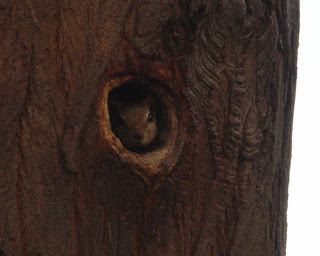
 The parakeets need a spacious bungalow and are now checking out the squirrel home. We barbets are sitting on the fence and watching the fight between the parakeet and the squirrel.
The parakeets need a spacious bungalow and are now checking out the squirrel home. We barbets are sitting on the fence and watching the fight between the parakeet and the squirrel.
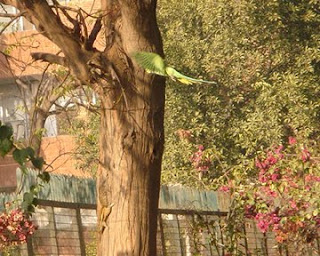
 Hey, but why is the tree looking shrivelled up? The squirrels have been extending the house illegally from inside, eating away the sap inside.
Hey, but why is the tree looking shrivelled up? The squirrels have been extending the house illegally from inside, eating away the sap inside.
 Looking at the withering tree, we know that it will not be able to weather the next winter storm. May be it is time for us to move on to another tree! (The more you observe nature, the more you tend to identify your emotions and feelings with it. That is the
reason why I have included this blog under"anthropomorphism")
Looking at the withering tree, we know that it will not be able to weather the next winter storm. May be it is time for us to move on to another tree! (The more you observe nature, the more you tend to identify your emotions and feelings with it. That is the
reason why I have included this blog under"anthropomorphism")
|
Posted by
Susan Sharma
on
February 14, 2010
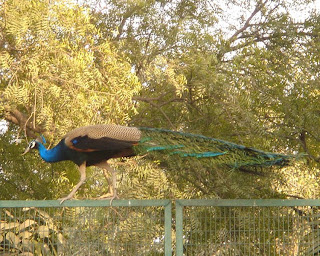 At last the cold winter of 2010 is on its way out and spring is here again. The redstart which heralded winter for us, is all set to disappear to higher plains till the weather beckons again.
At last the cold winter of 2010 is on its way out and spring is here again. The redstart which heralded winter for us, is all set to disappear to higher plains till the weather beckons again.
 The nasturium flower smiling at the sun gives itself completely to the grass blue butterfly.
The nasturium flower smiling at the sun gives itself completely to the grass blue butterfly.

 A peacock balances itself on the wall as the clouds proclaim a mild shower coming.
A peacock balances itself on the wall as the clouds proclaim a mild shower coming.
|
Posted by
Susan Sharma
on
December 28, 2009
 The Anaar tree which bears the Anaar (Pomegranate) fruit is valued in Ayurvedic and Unani systems of medicine. The fruit and its rind have nutritious values and healing properties. The pomegranate is native to the region of Persia and the Himalayan ranges
of India. It grows well in the NCR region.
The Anaar tree which bears the Anaar (Pomegranate) fruit is valued in Ayurvedic and Unani systems of medicine. The fruit and its rind have nutritious values and healing properties. The pomegranate is native to the region of Persia and the Himalayan ranges
of India. It grows well in the NCR region.
 The bird community seems to realize the value of the pomegranate fruit. Of all the plants and bushes in my garden, the Anaar attracts quite a few birds at all times. The soft spoken "white eyes" and the chirpy "bulbuls" relish the red fleshy seeds.
The bird community seems to realize the value of the pomegranate fruit. Of all the plants and bushes in my garden, the Anaar attracts quite a few birds at all times. The soft spoken "white eyes" and the chirpy "bulbuls" relish the red fleshy seeds.
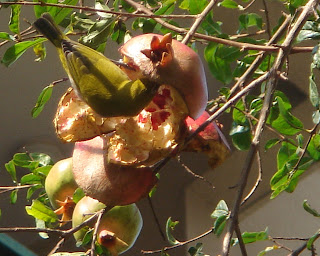
 The squirrel, evening brown butterfly and common Castor butterfly are the other regulars I have observed at various times.
The squirrel, evening brown butterfly and common Castor butterfly are the other regulars I have observed at various times.



|
Posted by
Susan Sharma
on
December 28, 2009
 This winter we have not had many butterflies in the garden; may be because it has been a dry winter with no signs of rains coming. So I was thrilled when the blue pansy flitted about under the morning sun. First on the yellow chrysanthemums and then on the
Asoka Tree.
This winter we have not had many butterflies in the garden; may be because it has been a dry winter with no signs of rains coming. So I was thrilled when the blue pansy flitted about under the morning sun. First on the yellow chrysanthemums and then on the
Asoka Tree.


|
Posted by
Susan Sharma
on
November 10, 2009

A visit to Kerala is never complete without a peek into the deep forests the State can still be proud off. Waiting nearly two hours to get permission to drive through the Illithod Mahagony Forest was forgotten once our vehicle entered this near pristine
forest. Till recently, we were told, the access to the forest was unrestricted and the area was a favourite with plastic throwing tourists. The State forest department stepped in and went a step further. They managed a court stay on the Aquaduct which was
being constructed on the banks, parallel to the River Periyar. The completeion of this canal would have meant no access for the animals to the river. For now the animals are happy!
 candle flowers grow wild on the roadside
candle flowers grow wild on the roadside
 entrance to the mahagony forest
entrance to the mahagony forest
 canopy of mahagony leaves
canopy of mahagony leaves
 an enveloping tree trunk
an enveloping tree trunk
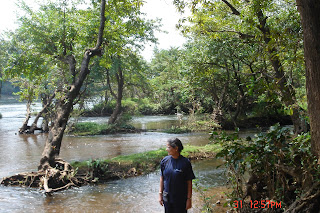 Periyar River (300km long) flows through the dense forest floor.
Periyar River (300km long) flows through the dense forest floor.
 strangler figs
abound (thanks to abundant bird life) strangler figs
abound (thanks to abundant bird life)
 the mahagony
survives and grows, unstrangled! the mahagony
survives and grows, unstrangled!
|
Posted by
Susan Sharma
on
November 08, 2009

Kovalam beach is a favourite with tourists for swimming in the sea. There are coast guards around who keep a watchful eye. The beach is advertised as ’jelly fish Free’ on the various travel sites. So it was a surprise to find large number of purple jellyfish
being washed onto the shore by the waves.

The coast guards assured us they are dead and harmless. The fishermen throw them out when they get caught in their nets. It seems there is a migration of jelly fish for about a fortnight in October, when the sea gets foamy with the gelatine in the jelly
fish. Kovalam beach never fails to arouse curiosity! Squids which made jelly fish their home, were seen crawling inside and attracted other beach goers. I am sharing a small clip uploaded in ’wildbytes’ channel of youtube.
|
Posted by
Susan Sharma
on
October 12, 2009
Economic governance: the organization of cooperation
Elinor Ostrom and Oliver Williamson win Nobel Prize for Economics 2009 on Monday.
http://news.cnpanyu.com/2009/1012/6856.html
Elinor Ostrom has challenged the conventional wisdom that common property is poorly managed and should be either regulated by central authorities or privatized. Based on numerous studies of user-managed fish stocks, pastures, woods, lakes, and groundwater
basins, Ostrom concludes that the outcomes are, more often than not, better than predicted by standard theories. She observes that resource users frequently develop sophisticated mechanisms for decision-making and rule enforcement to handle conflicts of interest,
and she characterizes the rules that promote successful outcomes.
|
Posted by
Susan Sharma
on
September 30, 2009

This year the rains came late and lingered till end of August. The butterflies and moth caterpillars waste no time in completing their life cycles; Here are some I managed capturing on the lens, in the beginning of September.
 The above picture is that of a lime butterfly caterpillar which is probably in its third stage (instar)of moulting. The picture below is that of the same caterpillar after two more moultings. Now it is in its last ’instar’ and the next stage will be the pupa
and then the lime butterfly. The host plant is the Chinese Orange tree.
The above picture is that of a lime butterfly caterpillar which is probably in its third stage (instar)of moulting. The picture below is that of the same caterpillar after two more moultings. Now it is in its last ’instar’ and the next stage will be the pupa
and then the lime butterfly. The host plant is the Chinese Orange tree.
 If the caterpillars of lime butterfly are fast eaters, they pale in comparison with the moth caterpillar’s eating capacity. The picture below is that of the Elephant Yam moth caterpillar. This one could devour huge leaves of the yam plant overnight and was
found hiding beneath the leaf during the day. I could not observe this caterpillar in its next stage; probably a mynah or babbler found this packaged fast food irresistible. The caterpillar disappeared sometime during the day.
If the caterpillars of lime butterfly are fast eaters, they pale in comparison with the moth caterpillar’s eating capacity. The picture below is that of the Elephant Yam moth caterpillar. This one could devour huge leaves of the yam plant overnight and was
found hiding beneath the leaf during the day. I could not observe this caterpillar in its next stage; probably a mynah or babbler found this packaged fast food irresistible. The caterpillar disappeared sometime during the day.

|
Posted by
Susan Sharma
on
September 26, 2009

I was in Kangra (Himachal Pradesh) late October, just before winter set in. As always, the countryside is ever changing and never fails to reveal something new for my camera to capture. The mongoose family scurrying about the neighbour’s vegetable fields
was amusing.
http://backyard-wildlife.wildbytes.in/#25
So was the sight of giant wood spiders alongside walking paths. The females are nearly ten times larger than the males, I believe. They weave the strongest and largest spiderwebs known to us. Shiny legs with yellow joints are their hallmark. Giant wood spiders
are the subject of research- Humans would love to know the secret of creating the strong golden websilk. "In modern times, the Golden Orb Web Spider’s silk is set to become a major product. The silk is almost as strong as Kevlar, the strongest man-made material
which is drawn from concentrated sulphuric acid. In contrast, spider silk is drawn from water. If we could manufacture spider silk, it would have a million uses from parachutes, bullet-proof vests, lightweight clothing, seatbelts, light but strong ropes, as
sutures in operations, artificial tendons and ligaments. Studies are now being done to have genetically engineered plants produce fluid polymers which can be processed into silk".
http://backyard-wildlife.wildbytes.in/#24
The wild red and white berries were all over.

The fields had spawned metallic mushrooms which vied with the pebbles lying around.

My husband was only too pleased to pose for a photo, framing a wagtail which he was pointing out to me!
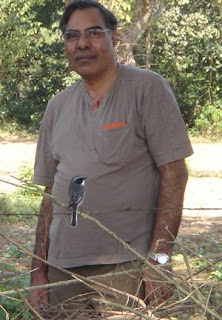 More on my next visit!
More on my next visit!
|